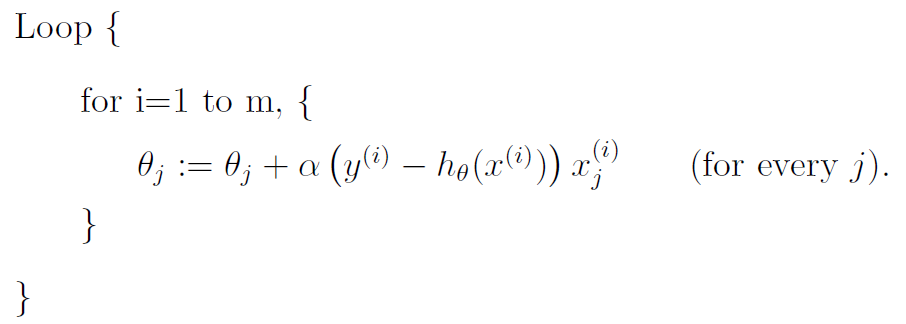最小均方算法(LMS Algorithm)及其matlab代码实现
线性回归的目的是寻找θ使得J(θ)取得最小值。如何使J(θ)取得最小值,可以采用梯度下降算法逐步逼近。
算法过程如下:
(1)初始化一个θ,可以取随机值;
(2)采用如下公式进行迭代:
其中,θj是θ的第j个分量,α是步长,也称为学习速率(Learning rate)。最后那一部分是J(θ)关于θj的导数。
对于只有一个训练样本的情况,我们有:

由此,可以得到一个训练样本时的更新规则:

这个规则称为LMS更新规则,也叫做Widrow-Hoff学习规则。上标i表示第i个训练样本,不是指数。
对于一个训练集来说,有两种更新的策略:
第一种,称之为批量梯度下降法,就是说每一次更新时,都要涉及所有的样本。更新公式如下:
![]()
公式中,m为训练样本的数目。参考一个训练样本的更新规则,可以很明显的看到,批量梯度下降算法是在每一轮迭代中,所有的训练样本更新规则相叠加。
第二种,称之为随机梯度下降法,就是说在每训练一个样本时,都进行一次更新操作。更新操作如下:

随机梯度下降法相对于批量梯度下降算法来说,它不用每次更新都把所有的训练样本都计算一遍,它的更新速度比批量梯度下降算法更快,消耗的内存更少。当然,随机梯度下降法每一次更新完成后,结果不一定会变得更好,甚至会变得更坏,但总体趋势是梯度下降的。当样本的数目m很大时,随机梯度下降法能更好的解决问题。
以下是批量梯度下降算法的matlab实现:
%LinRegTrain function is used to train data for linear regression.
%FEATURE is the matrix that composed of features of the training examples.
%VALUE is the matrix that composed of output values of the training
%examples.
%THETA is the parameter of the hypotheses function.
function [theta] = LinRegTrain(feature,value)
length = size(feature,2);
num = size(feature,1);
features = [ones(num,1) feature];
theta = zeros(length + 1,1);
alpha = 0.005/(num*10);
%theta = 1 + rand(1,length + 1);
for i = 1:100000;
delta = value - features*theta;
% costvalue = delta'*delta;
% if costvalue < 1e-10;
% display 'break the if condition'
% break;
% end
theta = theta + alpha*features'*delta;
% theta(1) = theta(1) + alpha*sum(delta.*features(:,1));
% theta(2) = theta(2) + alpha*sum(delta.*features(:,2));
end
hypvalue = features*theta;
plot(feature,hypvalue,'rx-',feature,value,'bo');
end
matlab中有一个regress函数实现线性回归,以上函数是自己写的,不是很严谨,但最终效果勉强能和regress函数差不多。其中最难控制的是其步长alpha,对于最终结果影响甚大。
























 被折叠的 条评论
为什么被折叠?
被折叠的 条评论
为什么被折叠?








